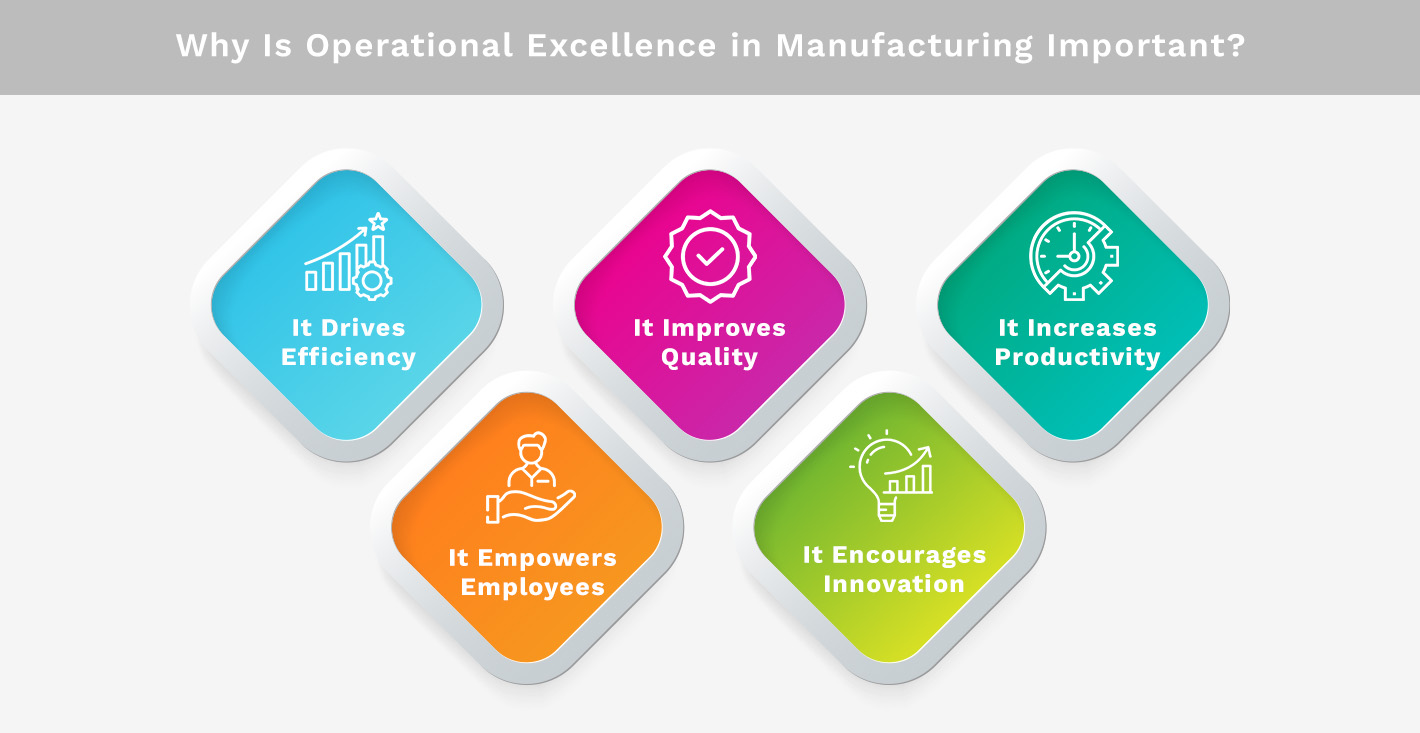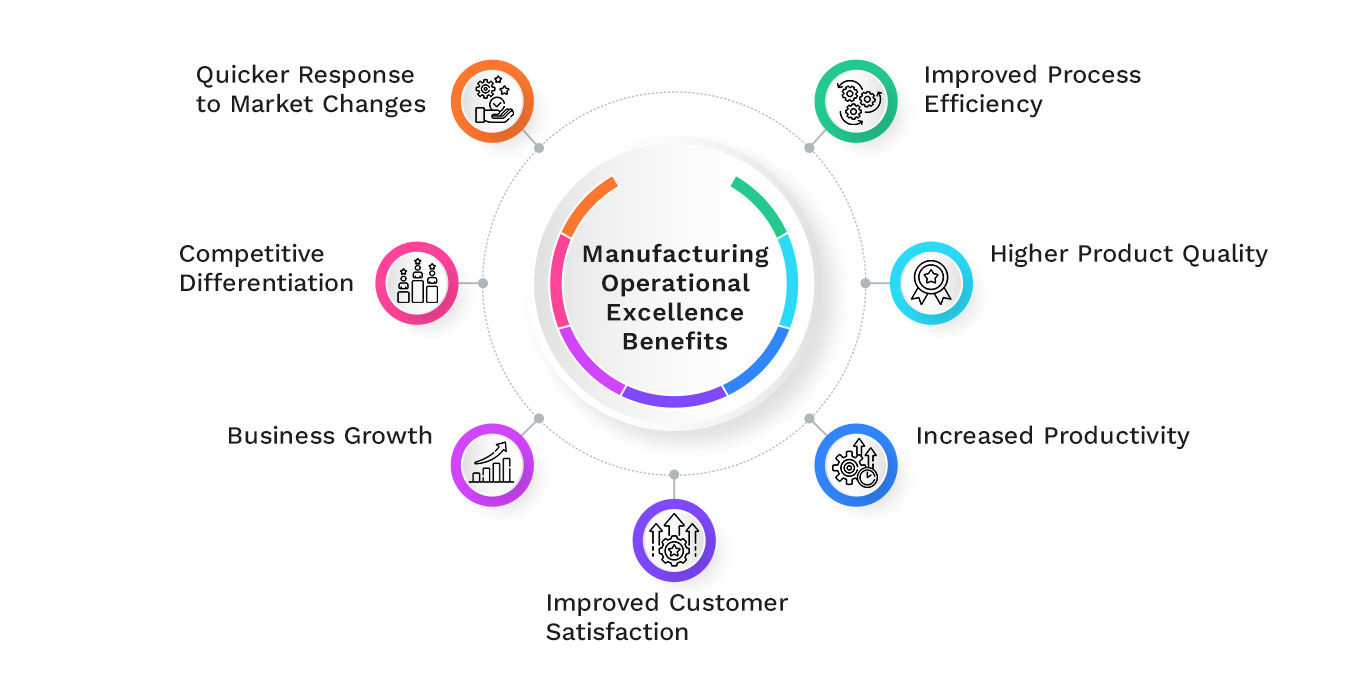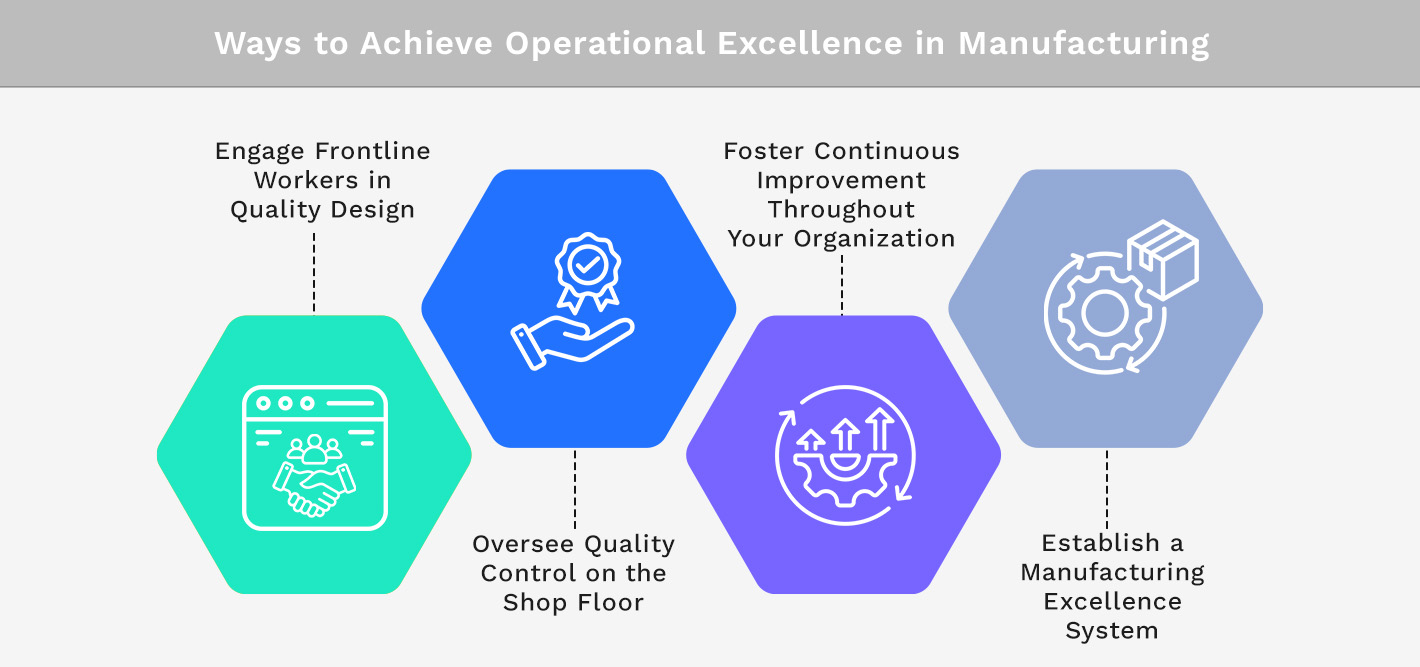Operational excellence in manufacturing is the practice of continuously improving processes to achieve high efficiency, quality, and productivity. Today’s manufacturers must focus on streamlining operations and minimizing waste to stay competitive. A study by McKinsey & Company found that companies with strong operational practices can achieve up to a 30% increase in productivity.
This article explains operational excellence in the manufacturing sector and offers practical steps to help your organization achieve this goal.
We'll buid your first application for you. At no extra cost.
Let us build your first business application for free. Go from an idea to an application in under 2 weeks.

What Is Operational Excellence in Manufacturing?
Operational excellence in manufacturing means conducting business in the most efficient, effective, and sustainable manner possible. It involves a holistic approach where every aspect of the production process is continuously scrutinized and improved upon. This concept is about establishing a culture where constant improvement becomes the norm.
Operational efficiency has four guiding principles: Respect for people, problem-solving, process efficiency, and sustainable results. Implementing these principles allows manufacturers to achieve a state where the system, process, and employees work in harmony. This enables them to deliver products that meet or surpass customer expectations, ensuring long-term business growth.
Why Is Operational Excellence in Manufacturing Important?
Operational excellence in manufacturing is a critical component of a successful business strategy. Let's break down why achieving this golden standard in your operations matters:
- It Drives Efficiency: Eliminating waste and streamlining processes helps you reduce costs, saving money that can be reinvested elsewhere in the business.
- It Improves Quality: Focusing on operational excellence means a commitment to quality at every production stage. This can lead to fewer defects, returns, and higher customer satisfaction.
- It Increases Productivity: When processes are refined and workers are engaged, productivity climbs. High productivity translates to increased capacity, potentially opening doors to new markets and customers.
- It Empowers Employees:A culture of excellence values each employee's contributions, providing them with the tools and confidence needed to excel at their tasks.
- It Encourages Innovation: Striving for operational excellence naturally encourages innovation, as employees and management constantly look for better ways to accomplish tasks.

How Does Manufacturing Operational Excellence Benefit Your Company?
Operational excellence in manufacturing offers several key benefits for your company. Here are the main advantages you can expect:
Improved Process Efficiency
When you prioritize process efficiency, you'll notice a substantial decrease in cycle times, a smoother flow of production, and a reduction in downtime. Fewer bottlenecks mean that products move from conception to delivery faster than ever before without sacrificing quality. It also means a reduction in manual and repetitive tasks through automation, as well as better utilization of resources, including machinery and manpower.
Higher Product Quality
Incorporating rigorous quality control systems and continuous feedback loops into your operations can help you ensure your manufacturing processes consistently yield the highest-quality products.
Key factors contributing to higher product quality include advanced quality control methods that catch defects early in the process, the use of superior materials and cutting-edge technologies, well-defined standards and specifications for each product, ongoing employee training, and customer feedback integrated into the product development cycle.
Increased Productivity
When processes are fine-tuned, and employees are engaged, you witness a substantial rise in output without a corresponding increase in resources or expenses.
Proper training and modern tools, minimizing idle time and improving workflow, integrating technology to automate repetitive tasks, and measuring performance with precise data are some of the steps you can take to increase productivity.
When your productivity increases, it can lead to heightened employee morale as well. Plus, higher productivity often correlates with better financial performance, allowing for more investment in innovation and growth initiatives.
Improved Customer Satisfaction
Improved customer satisfaction is the natural byproduct of operational excellence in manufacturing. Satisfied customers are more likely to become repeat buyers and brand advocates. This can significantly impact your company's reputation and bottom line.
What does it take to elevate customer satisfaction levels? Consistently delivering high-quality products that meet or exceed expectations, reducing lead times and ensuring timely deliveries, providing excellent customer service, offering products that provide value, and gathering and acting on customer feedback.
Business Growth
When your manufacturing processes are fine-tuned, and your customers are satisfied, expansion becomes a part of your natural progression. This growth is about sustainable development that adapts to changing market demands while staying true to your company's values.
Key aspects of business growth include expanding into new markets, innovating new product lines, strategically scaling operations without compromising on quality, and developing a resilient supply chain.
Competitive Differentiation
When your company excels operationally, it can offer something unique that sets it apart from the competition. This could be faster delivery times, superior product quality, or exceptional customer service.
Quicker Response to Market Changes
Quicker response to market changes allows your business to adapt swiftly and stay competitive. Implementing lean manufacturing principles to minimize waste, investing in flexible manufacturing systems, utilizing predictive analytics to anticipate market shifts, and strengthening communication channels within the organization are some of the steps you can take to improve your responsiveness.

Ways to Achieve Operational Excellence in Manufacturing
Achieving operational excellence in manufacturing requires specific strategies and actions. Here are some effective ways to reach this goal:
Engage Frontline Workers in Quality Design
Engaging frontline workers in quality design is a powerful method to foster a sense of ownership and collaboration. These individuals are hands-on with the manufacturing process, and including their insights can lead to practical and innovative improvements.
Implement frontline-friendly systems, like intuitive downtime tagging interfaces, that make it easy for workers to offer feedback. Encourage operators to provide context on production processes to identify bottlenecks and slowdowns actively. Incorporate employee suggestions into design modifications, showing the workforce that their input has a direct impact on operations.
Oversee Quality Control on the Shop Floor
Real-time oversight allows frontline workers to immediately identify and address quality issues. The goal here is to promote a culture of quality from the ground up, where every team member is empowered to take responsibility for the final product.
Achieving top-notch quality control might include utilizing spreadsheets, whiteboards, or advanced software to track inconsistencies and other quality data, performing regular team stand-ups to discuss challenges and solutions to quality concerns, or employing Industry 4.0 technology for immediate and actionable notifications regarding quality flags.
Such proactive measures ensure products consistently meet the set standards and that any deviations are swiftly managed.
Foster Continuous Improvement Throughout Your Organization
All levels of the workforce, from top management to frontline workers, should actively pursue opportunities for improvement across every aspect of the manufacturing process.
Effective ways to embed continuous improvement include establishing regular training programs, setting up clear channels for employees to voice suggestions and report inefficiencies, viewing failure as a learning opportunity, and integrating KPIs to track progress.
Establish a Manufacturing Excellence System
A Manufacturing Excellence System (MES) serves as the framework for integrating all aspects of operation and ensuring that each step meets the highest standards of quality and efficiency.
The key components to consider when setting up an MES include a comprehensive policy that outlines the goals and processes of the MES, rigorous training protocols, continuous monitoring and analysis tools to assess performance and identify areas for improvement, and a standardized set of practices and tools that streamline production and maintenance.

Achieve Operational Excellence in Manufacturing with Kohezion
Unlocking the full potential of operational excellence in your manufacturing processes can be challenging, but with Kohezion, it becomes an attainable reality. Kohezion takes the complexity out of data management and process optimization, providing an accessible platform that simplifies the execution of your manufacturing excellence strategy.
Leveraging Kohezion for operational excellence offers benefits such as user-friendly database solutions that require no programming skills, cloud-based access to real-time data, and a scalable framework that adapts to growing business needs.
Kohezion’s platform is designed for businesses seeking to streamline operations without the overhead of complicated software solutions.
Conclusion
Operational excellence in manufacturing drives efficiency, quality, productivity, and customer satisfaction, leading to robust business growth and competitive differentiation. It involves a cultural shift towards continuous improvement and a focus on detailed success metrics.
Engaging frontline workers, overseeing quality on the shop floor, and establishing a Manufacturing Excellence System enables your company to respond more quickly to market changes and sustain excellence.
To harness the full potential of these efforts, consider using tools like Kohezion, which can centralize data management and increase accessibility across your organization. Contact us today to find out how we can help you achieve operational excellence.
Start building with a free account
FAQs on Operational Excellence in Manufacturing
Yes, small manufacturers can reap significant rewards from adopting operational excellence principles. These practices help to streamline processes, reduce waste, and maximize resources. Plus, the agility of smaller operations often allows for quicker implementation and more visible results.
Technology provides the tools and data necessary to streamline processes, predict trends, and facilitate decision-making. From IoT devices collecting real-time operational data to AI algorithms analyzing efficiency metrics, technological advancements empower manufacturers to achieve higher productivity and quality with less waste.
Yes, industry-specific approaches to operational excellence in manufacturing exist due to the unique requirements and constraints of different sectors. For instance, the automotive industry often uses lean manufacturing and just-in-time production, while the pharmaceutical industry may focus heavily on compliance and traceability.
Sustaining operational excellence over the long term involves cultivating a culture of continuous improvement, regular training, and open communication. Companies should embrace innovative technologies, measure and track progress using key performance indicators, and encourage cross-team collaboration to address issues swiftly. Most importantly, they must remain adaptable to the evolving business landscape to maintain a competitive edge.
Success in operational excellence initiatives is measured by evaluating key performance indicators (KPIs), such as reduced operational costs, improved product quality, higher customer satisfaction scores, increased productivity, and improved safety records. Tracking these metrics over time gives you tangible evidence of progress and areas that may require further improvement.

